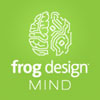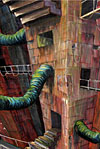Frog Design Mind newsletter on identity and meaning in the world of design
Defining The New Singularity
Exploring the next level of convergence: between hardware and software, information and object, human and technology.
“As the writer Bruce Sterling puts it, borrowing a bit from Baudrillard and applying it to design, we are now approaching an age of technological advancement when ‘there is more stored in the map than there is in the territory’. Put more simply, the story surrounding a given ‘thing’, a product or service we buy and use, is rapidly exceeding the value of the thing itself. The identity of a product can no longer be easily defined through its form factor, but rather by the information that encases it, passes through it, and is accumulated by it over the course of its lifetime.”
Change Agency and Transformologies
Understanding the power of design to facilitate positive change in the end-user.
“Can personal development be better shaped by the technologies we, as designers, create? What if products and environments were designed to acknowledge individual aspirations and facilitate the realization of users’ potential? Could our products not only change users’ behavior, but actually foster within them the qualities that they seek?”
Parenting 2.0
Key principles for the creation and curation of your child’s online identity.
“The purpose of this article is to provide you, the parent, with some basic principles for navigating the wonderful world of social networking and Web 2.0 with your children – all while keeping them safe, socialized, and engaged. They are not rules, or guidelines, or a philosophy of parenting. They are just basic principles that remind you, and your kids, to think before you press that Enter key.”
Is Your Hard Drive Worth More Than Your Life?
The influence of technology on the collective experience of today’s families.
“Before the presence of cameras and the like, humans passed on knowledge through storytelling, intertwining personal experience with a sense of place and time. They created visual landscapes through words, art, and the objects around them. This storytelling codified a shared sense of experience, bringing the audience into a collective understanding of their culture and environment. As the stories were passed on, every teller became a part of the tale – rendering history subjective, reality shared. In our frenzy to safeguard our memories in the online world, we have removed the intimacy of storytelling. We have made the web, not each other, the major source of shared experiences, knowledge, and opinions (often not even our own).”
HBR: Melding Design and Strategy
In the September 2007 issue of Harvard Business Review, frog Strategy Director Ravi Chhatpar published the following article, outlining the benefits of an iterative design process, in which design and business strategy impact one another directly.
“From concept through development, designers should function in parallel with corporate decision makers, creating prototypes for a number of variations on a product and then testing them with users and, if appropriate, partners. Tracking how customers’ ways of using a product evolve over time also makes it possible for designers to identify desirable new features and, in some cases, create new functionality in conjunction with users.”










[…] design on Identity and Meaning—some links to interesting articles, particularly one on Parenting […]